For the third instalment in my series Origin Stories, I had the pleasure to talk to Asger Harding Granerud, one of the two designers (with Daniel Skjold Pedersen) behind what is very likely the most in-demand board game of 2023, Heat: Pedal to the Metal. Fresh off a prestigious nomination for the Deutsche Spielepreis, I sat down with Asger as Daniel was heading out to test more prototypes. One gets the feeling these two are not resting on their laurels but instead are invigorated by the success they are having with Heat.
The full conversation was 90min long, so I had to edit it down to a readable length and split it into two parts. This is part 1, in which we talk about the origins of Heat, creating the illusion of racing, and how Daniel and he approached track design. Enjoy!
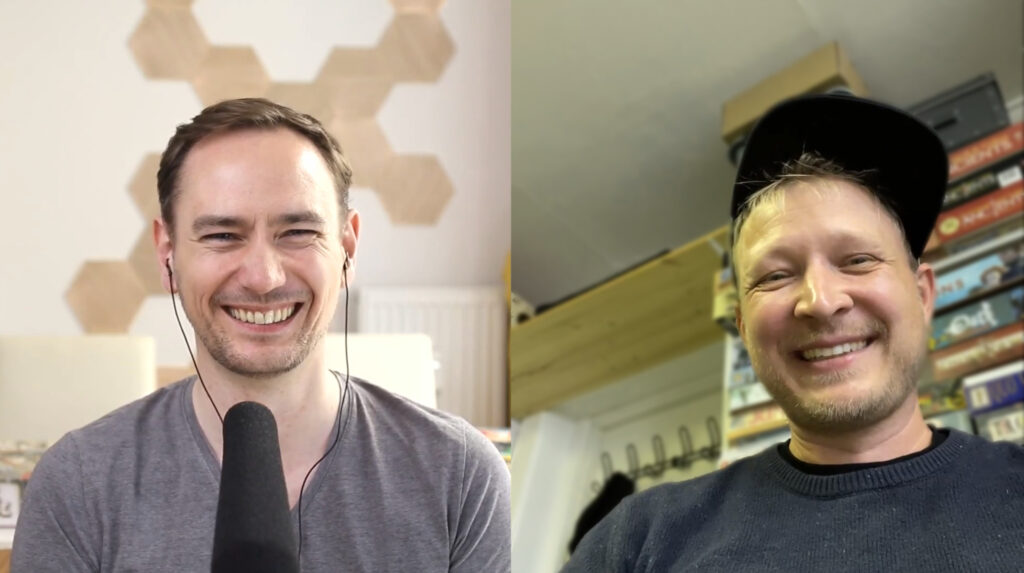
Introduction
When I did my research, I thought to myself this is a great opportunity because you are in the middle of having a success. It’s not completely done, it can still grow much, much bigger, but there is already so much to talk about. For me, it [reminds me of] hitting a ball in baseball: we know it sounded good, it’s flying and flying and we are anxious “is it a home run yet?” or does it even go over the parking lot?
To sum it up, since it’s release in 2022, Heat has been one of the most consistently in demand and discussed games on BoardGameGeek. By May, it was already in the BGG Top 100 and there is actually a discussion thread called “Thanks to all and soon back in stock” that has 448 replies of people trying to find the game and people sharing “finally I got a copy!”, giving each other tips. It’s crazy, I have never seen something like that. All the reviews I could find were all positive. And not only positive but glowing, like “hey, this is an amazing game”.
Heat has won a Golden Geek Award and was just nominated for the Deutsche Spielepreis. But despite all this success, I think the most astonishing thing about this game is: it’s a sports racing game. To put things into perspective: I checked the BGG rankings and the next racing game behind Heat is 60 positions down and it’s Rainer Knizia’s The Quest for El Dorado, and that’s an Indiana Jones style racing game. What you have done is a sports racing game! And then I checked the ranking again, went further down [the list], and what do I see: Flamme Rouge, also by you. So you guys must have cracked the formula for sports racing games!
Inception
I want to step back a bit and chat with you about how it all began. Who of the two of you came to the other one and said “You know what the world needs? Another racing game!” and what was the pitch like?
Obviously, up until Heat, my biggest hit was Flamme Rouge and it has been selling and is still in print seven years after being released. It’s a system I knew very well, having made expansions for and dabbled in it. But I don’t think there was a clear me going to Daniel and talking about it or Daniel coming to me. We sit together almost five days a week, working, so we have so many ongoing conversations that at some point it was just natural to say that it should be possible to probably use some of this core [of the mechanics of Flamme Rouge] but in a new way […] to make a car racing game. Before we ever did a prototype, we had lots of talks about what’s different between a person getting tired and a car racing. All of these things are very fundamental to the game at a simple mechanical level and then from there it’s build up into its own beast.
So there wasn’t like a clear start. It was an ongoing brainstorming process, mostly just talking about it until we then decided to give it a go. And when we did so, we felt – almost before making the first prototype – we felt that we should have a game here that should work because we knew so many of the mechanical elements. Obviously, we tried to overcomplicate it and made so many things that were too complex for what it should be and what it [became] along the way.
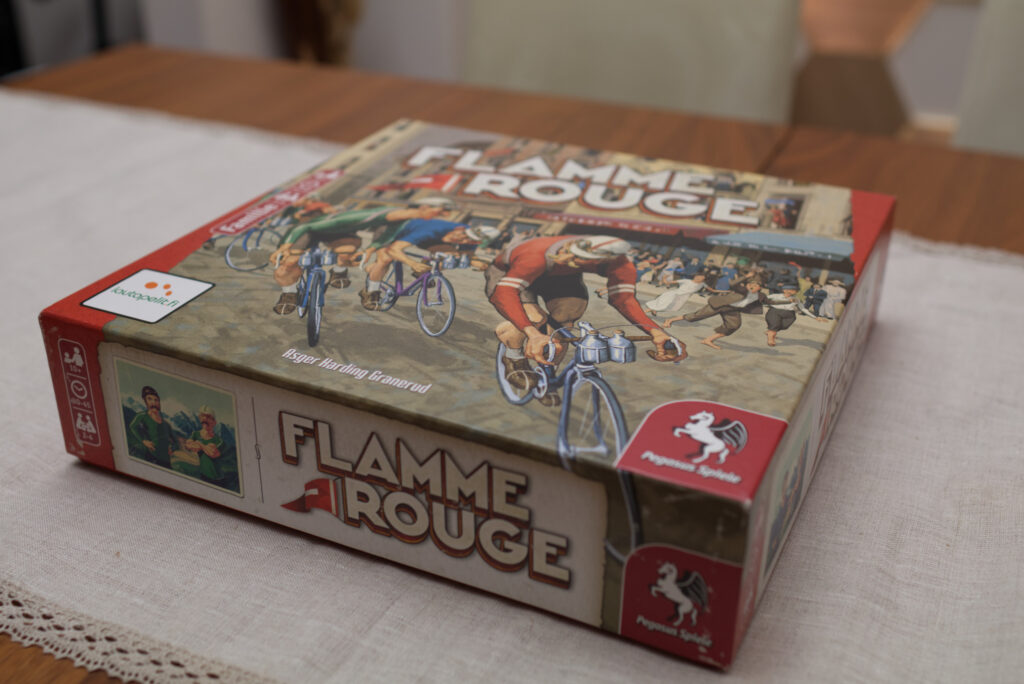
Was the challenge part of it? That you thought “hey, there must be space for a racing game”?
Oh yes, that as well! I’m an okay fan of racing games otherwise. But in my humble opinion, I don’t think Formula Dé – which is a role-and-move game at its heart unless you go all in and play with all the expansions, etc – it’s not a satisfying experience for me because even if I make the right decision, I can get fully punished by output mechanics of a die being rolled. And if you add everything in … even for the base game, you are often looking at a 2 hour experience or even more, and that’s [without] running several laps, etc. So we very much felt that not only should we be able to use the system here to make something with simultaneous play, where everyone makes decisions more or less at the same time – so it [would] be able to play at a large player count at a rapid speed – but also that there should be room in the marketplace for someone to outcompete Formula Dé basically, which was our ambition. A lot of the reviewers obviously make comparisons to other racing games, Formula Dé being one of them, and we have seen again and again in the comments that people think this outdoes it.
I’ve mentioned this before in other interviews and blog posts, but there is a difference for me in a racing game where there is a racing theme – like Camel Up – where you win based on betting and not necessarily on being first across the line. For me the definition [of a racing game] is when it not just thematically plays in a racing universe but is actually a racing game you must win [by being] first across the line or furthest in a turn or whatever you define it. But it should be like: a push of speed should win.
When you started designing Heat, what was your and Daniel’s living situation? Were you already full-time developers? And can you give me a sense of when it started?
So I believe we started working on it in 2018 and a few years before that we had gone full-time designing. Before we went full time designing, we had gradual periods where we then went like one day a week. And of course we did evenings and weekends for playtesting, etc. So it was a gradual progress towards doing more and more game design over like a 3 to 5 year period and then full-time ever since.
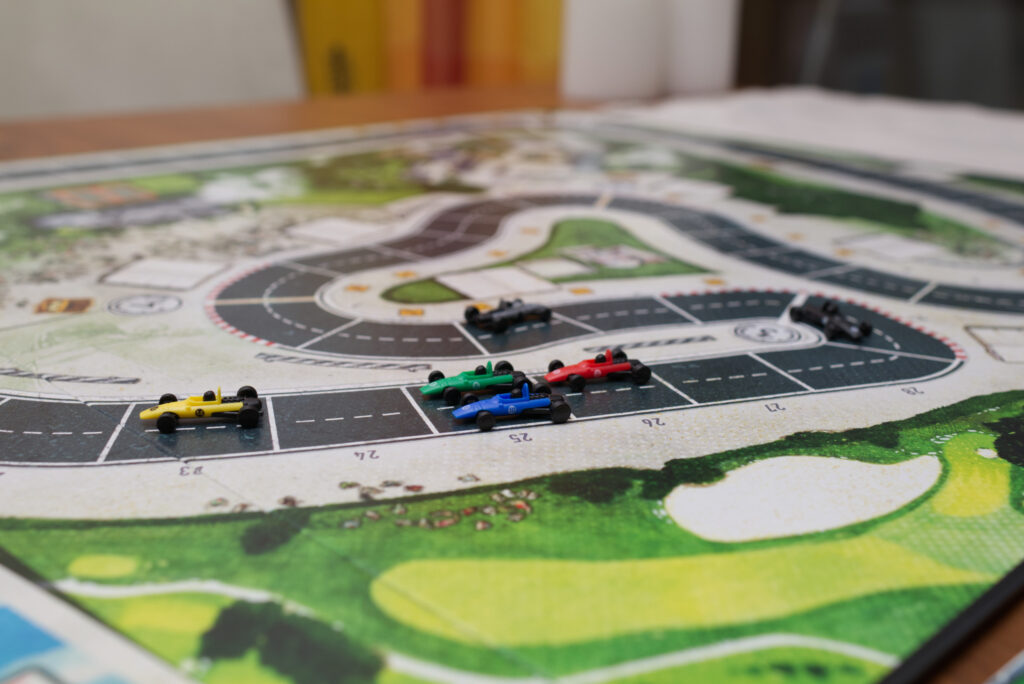
Was Heat just one project among many or did you have a feeling of “okay, this is the next big one”?
So we very much felt it was the next big one but of course we do many projects at a time. We also have our own [publishing company] where we publish our own games occasionally, but mostly we have so far designed for other publishers. Heat was the first game that actually inspired us to consider publishing ourselves. We believed in it so much that we only showed it to one publisher! Normally we shop them around but we really wanted to see if Days of Wonder would be interested. It would also be a different fit in the niche of games they had, so we thought they could be interested [in Heat] and the whole business model as well. And then they said yes! We actually gave them a deadline [laughs]: “okay, by the end of the month, you have to make a decision because otherwise we are probably going to publish it ourselves.”
We are super happy that we did not publish it ourselves! Because while we do great games, [they are] much less complex productions and we are a tiny, tiny publisher. So handling all the logistics in getting everything right in as big a box and as big a game as it ended up being is very much to the credit of the team at Days of Wonder.
Yeah, it’s one of the most frequent comments how much content is in the box and how great the artwork looks. So it would have been difficult for a small independent publisher.
Very difficult!
Design Decisions
When you had your discussions, you at some point must have drawn your first prototype and tried to see if there is something there. What did it look like and how different is it to the game we as the players know now?
Well, Daniel and I, we put an honour into making extremely rough and expandable prototypes for the first test and then we just have to use our imagination and not care about all the things that are not right. So our philosophy is: once we start working on something, ideally we play it that same day.
And of course we are always playing like a bastardised half-version of the game because you cannot play a full game at that time. But you can start playing around with some of the core elements and mechanics of it and just get a feeling of that. And I believe the very first prototype unsurprisingly was just on Flamme Rouge tracks. Just some quick cards with some numbers handwritten on them and some Flamme Rouge tracks, because that was what we had lying around and it solved the problem.
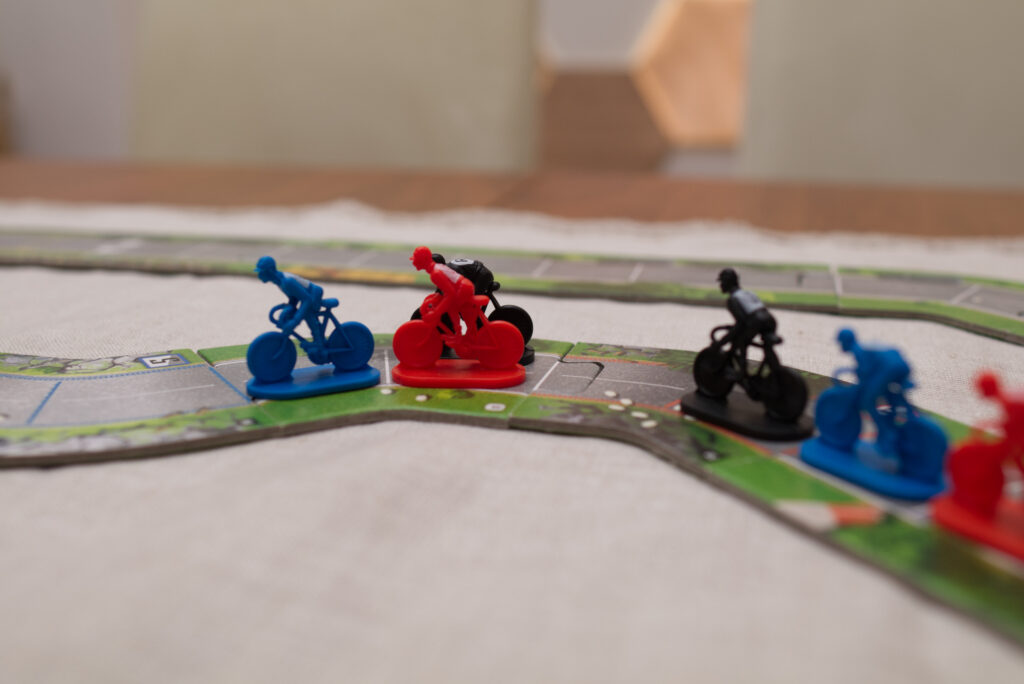
That’s very pragmatic! I also heard that when you designed tracks later on, you took a piece of string, marked it off, and used that to create your tracks?
Yes, that’s correct! And often we hand draw our first prototypes because we make so many corrections to them anyway that sitting down and using too much time to make something even remotely pretty digitally and then having to go and print it – if you are printing big things … Just draw it out and make due. For our sake it can be pretty rough and our play testers are also used to our games being basically white paper with some lines on them [laughs].
One thing that stood out for me when I first got the box in my hands is the theme. It’s not modern day racing, it’s in the 60ties and you said in another interview this circumvents a lot of problems modern racing has. All the controversy is gone, it’s more opening up the imagination of players that this is the raw time when cars had different equipment and everything. How soon did you make this decisions? Was this also something coming from Flamme Rouge you realised worked well there, it would probably solve a lot of problems here as well?
The logic behind it is the same and of course we had seen it work for Flamme Rouge, so the inspiration was from there. But it’s a straight forward idea that anything current always has the potential to get people agitated because they have strong feelings about it. And if it is something that happened sixty years ago, very few people have strong feelings about it. So from a pragmatic point of view…
And not only do they not have strong feelings about it. The feelings they have are the nostalgia and the dreams or the Hollywood movies, whatever depiction of it. […] We are not making Heat the racing simulation game, we are making Heat the Hollywood movie, where it doesn’t have to be exact to reality. We can embellish the story and pretend that some things worked that didn’t work in reality but if it makes a better story, that’s what we go for.
It might be a strange question as a follow-up, but did you do any research when you thought okay, car racing, sixties. Were you watching movies or books to get inspired?
I have watched a little bit of old racing movies and I’ve done a lot of talking with Daniel about what is the core of racing actually. Daniel has watched a lot more movies and has read books, etc, so he is much more of a researcher than I am.
I often think that the reason that up until Flamme Rouge no one had made an accessible, simple bike racing game, and up until Heat no one had made a modern [car racing] one where it flows as fast, is that often the people trying to make those games are people who are big fans of the genre and maybe they know too much [chuckles], to put it mildly. If you know a lot, then you want to put all your knowledge in the game somewhere. And I very much try to say what is THE most important aspect we MUST capture in order to present the illusion – because of course it’s a board game, it’s not racing Formula 1 cars around a track – to create the illusion of a Formula 1 race. So it’s very much about finding the simplest tools you can use to get people into that mind space, that feeling of it, not trying to recreate reality by too much research or knowledge. Knowledge is fine, but then you must be able to ignore it. [both laugh]
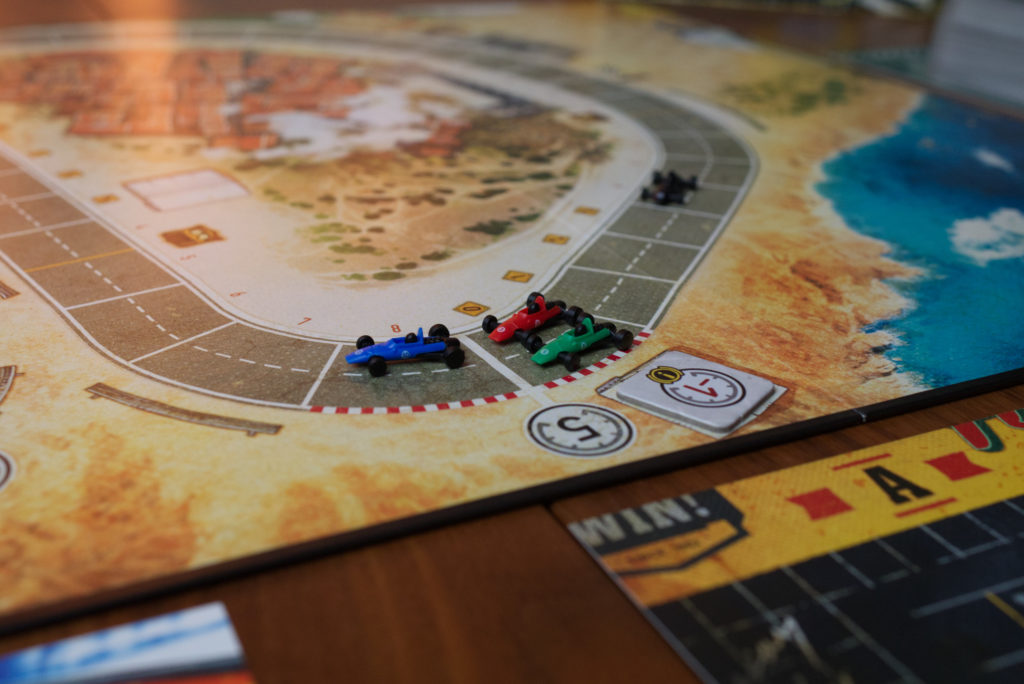
I think Shut Up and Sit Down put it best when they said that Heat doesn’t feel like how Formula 1 IS, but how people THINK it would or should feel like, right?
That’s actually also one of the points of this thing about creating the illusion of it. If we succeed in making this mainstream car racing game, then so many people will – I’m sure – play it that are not at all interested in Formula 1 racing. Maybe some of them will become [interested]. I know that has happened with cycling, which is great and a fantastic way of feeling you impact peoples lives in such ways. But it’s exactly right that all of these people are almost more important to deliver something to in the game than the person who knows everything. Because again, if you know everything, you will … it is an illusion, you will always find the cracks in the illusion because they are there all over the place. But for all the people who don’t know it, if we manage to hit them on the Hollywood version they feel like it should be, then we have done our job.
It’s an amazing job you did because racing has so many aspects people think about, like the cars, the drivers, the engine, the tracks, weather, breaks, crashes, and so on. How did you decide which elements you definitely had to have in the game and for which elements you had to say “okay, we would like to have them, but let’s just keep it out”?
So you mentioned a lot of things there and I think you failed to mention the two most important elements for me of a racing game. And it’s super simple. You will also see this in some reviewers and commenters mentioning it. The two most important elements are: you want to go fast, because it’s Formula 1, that’s what it’s known for. You must have that feeling of moving really, really far, which only makes sense if you sometimes move really slow, which means you need the corners. So you need the experience to go between these extremes. And then of course not only those two extremes but all the nuances in between is what makes it an interesting game that it’s not like either / or but has all these small dilemmas. But it is basically the corners and the straights, those are for me the two most fundamental aspects of racing … [chuckles] as a non-racing Formula car racing fan.
It’s funny that you mention that because I left them out intentionally as that’s my next questions [both laugh]. I completely agree with you. In my head, it’s not even the straights, it’s this daring people to go faster. Try to be a little bit faster. You shouldn’t play it safe, you should be a little bit faster because otherwise people will [leave you behind]. But there needs to be this penalty if people go too fast. That’s the duality as I saw it.
The question for me is: how did you come up with that simple and elegant design for the corners? Because it’s not saying yes you can go here or not, it’s like daring people, saying yes you can go as fast as you want around this corner but you have to invest heat in it.
Well, the game went through numerous iterations and even for the corners, we tried so many different things before settling on this simplest version, because we wanted to give people choices. And we wanted it to look like racing, that you ideally position your car in the right space around the corner, etc. so that when you take a picture of it and show it to someone who doesn’t know the game but knows racing, they don’t look at it and say “that’s wrong”. So that’s why we tried so many different things.
For the mechanical aspects of the gameplay, we knew we wanted to give you like simple tasks every turn to try to achieve. And of course your tools to achieve them are build [upon] what you did in the past turns and what you have left in your hand, which then [leads to] interesting dilemmas in and off itself. But if you couldn’t go faster through a corner, if you couldn’t occasionally break the rules, then it would be a limited game space. If you could break the rules in small ways, here and there, be it going faster through the corner or doing a boost or something else, then you can end up in the dilemmas about WHEN it is you want to break the rules. The more dilemmas you have in a decision space, the more regret you can have. And even though regret can be a negative thing in real life, it’s actually a good thing to plant in people for game design because it makes them want to play again or say “oh I should have tried it differently”. It’s a conclusion. Regret is a conclusion of having dilemmas that are not easy to decipher.
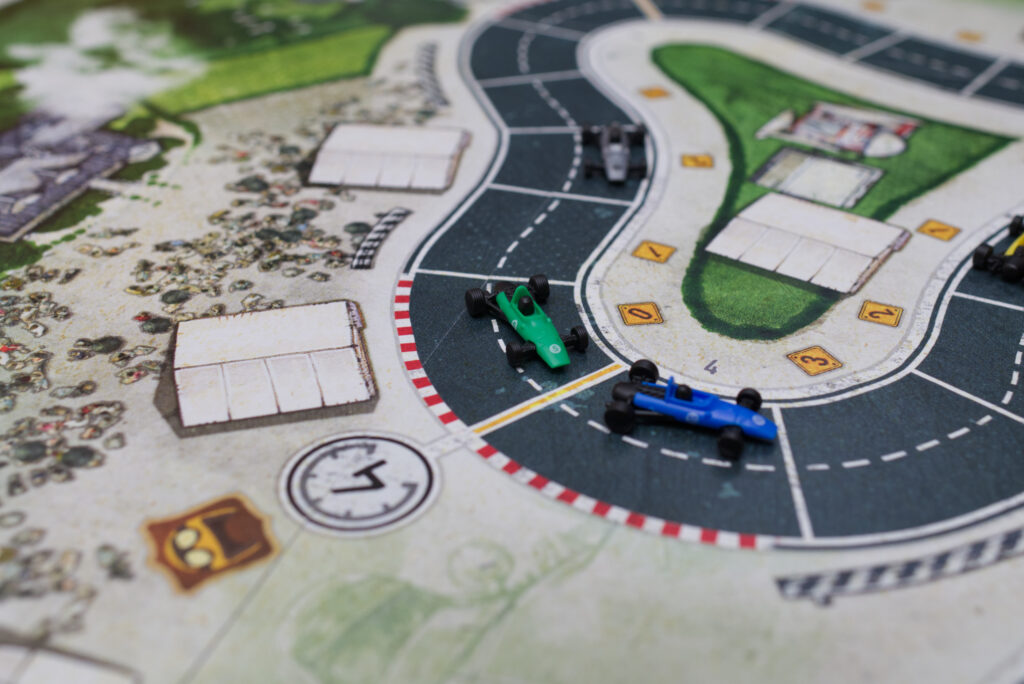
The counterpart to this crucial element of the corners and the speed is what to do if someone breaks the rules too much. How did you decide on the spin-out mechanic? Because it must be so difficult to find something that is penalising but not so much that someone is completely out of the game.
Yes. And again, we went through many, many, many different iterations of doing it and it is exactly the right question you are asking because it must be penalising enough that it doesn’t become a strategy to spin out, which is like the number one priority. You must not be able to actively use it as a tool. And I think it’s even possible to create technical situations in the [game] today where you are in the exact right position and others are in the right position. Maybe it is then still beneficial for you to crash or spin out.
The number one is to avoid that as much as possible and number two is to make it a certain penalty but also insuring that you still have a chance. And we quite early on in the core mechanic wanted to add the stress cards that add a randomiser that you have to find the timing-wise correct way to use – again, dilemmas are good and you can end up regretting them. And there is also skill in knowing somewhat what’s left in your deck but those cards just became a natural way of penalising the players that spun out.
The first penalty is pretty obvious, right? If you used all your heat, your heat is gone, and the second penalty is also obvious: you shouldn’t be able to do it and still get all the speed you wanted to go through the corner, so you must move back before the corner. You mustn’t inadvertently solve what you didn’t solve. So those seem pretty easy to understand and then the stress cards put in the long term worsening of your deck by going directly into your hands. And the difference between being in the high gears where you get double the penalty in stress cards and the single penalty is that you can end up in a situation where you are in the lower gears and you could spin out again and again and again and we don’t want it to just mean that you are like literally out of the game in front of a slow corner, never getting away from that situation.
There are some discussions on the internet: do you think if someone spins out, they actually have a chance to win?
Absolutely! It happens all the time. If you spin out early, let’s say you were in front and spin out in a low gear, well now you are with the rest of the pack and all you have is an extra stress card. Sure, that’s a worse deck but it’s also just more [chance]. If you then have that extra bit of luck, you are fine, right? So it’s certainly possible and we see it time and time again.
It’s also possible to still spin out and be completely out of the game. If you are already in the back and you spin out, chances are you are never catching up. Which is a problem with games that have these corners where you either make it or do not make it. It’s a technical design problem because it becomes very much a question of are you a turn ahead or a you a turn behind? It becomes very binary instead of more fluent, which has advantages and disadvantages but generally it’s not a good thing to know if you lost or know if you can’t win, etc. which can happen in these situations.
The heat does elevate some of this because you could be a turn ahead of me Alex. However you could have zero heat and I could be a turn behind you and I have 6 heat, so how does that count as a turn? I would count this probably as more than a turn if that differences was all the way there, especially depending on where your heat was placed in your cycle of cards going through your deck. So we also used that as a way to try to make a [corner] not just either / or because the heat is there, too.
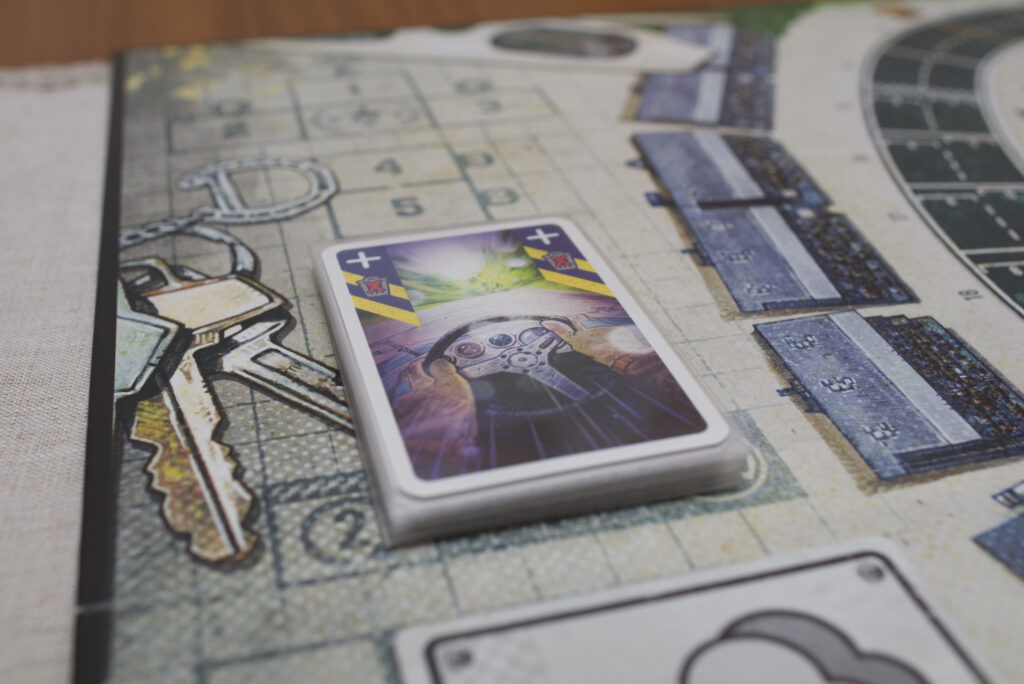
Is that also a reason why players start with stress in their deck and sometimes in their starting hands? You could have used stress just for the penalty of the spin out but instead you chose to give every player three stress from the start. So it feels like you were thinking about probabilities of someone winning or not. No player can ever be certain that they will win even if they are in the lead.
We knew we wanted to create a game where you hope something good will happen. Like that feeling of even flipping over a card in other games, just having something being resolved, rolling a die, puts a feeling of excitement in people’s guts. So it’s partially psychological for that but it’s also very much a way to somewhat level the playing field and make it a little bit more of a family game. Because if you remove it and make it pure numbers, then whoever is good at math or counting will get a decisive advantage and this somewhat, not only, but somewhat limits the playing field.
Of course there is also skill of how and when you play your stress cards. One of my favourite ways of doing it, if I can get away with it – and there are many situations in which this would not be a good idea – but if you were on a straight on a technical place and you don’t care too much about exactly how far you move, you play your three stress cards while you only have two cards left in your drawing deck. It means you are gonna turn over those two, then you are gonna shuffle, and you are gonna turn over one more and where do your stress cards go after your turn? They go in your discard which is now almost empty and you have a run through your entire deck without having to worry about stress cards. So there is a lot of timing and also management in how to handle it still. It’s not only levelling the playing field, it becomes another like [laughs] [expert] management level potentially.
For me that’s still one of the most difficult aspects of playing Heat really well, finding the right place where you can play the stress.
It’s as I just said: the dilemma which ends up becoming a regret which ends up becoming a reason to try to solve it better in the future. Or try a different approach to solving it in the future, take a different chance. All of these things are ways to both deliver good internal thinking while people are playing games but also just good experiences because everyone can sit and look at that card being flipped. Initially, it was a die roll being rolled, a long time ago.
You did something with stress that is kind of annoying for the hard core gamers, which says you are not allowed to check your discard pile. It’s always this hidden, trackable information where I’m thinking: why? I can just count the cards. Was that your thinking? Like “hey, lets add another challenge there” or was it like “hey, the effect of this is mostly for the casual players. They have the risk factor, and the pros will count anyways, so let’s just say they are not allowed to check”?
So we tested all of it. For the longest of times you were allowed to check. This is something we played around with. We made some changes in a previous version, the one previous to [the current one]. All cards had a number, so it wasn’t just the speed cards you flip towards. You flipped a heat card that would have a number associated with it for when it was flipped and only used for when it was flipped.
But once we removed all of those – also just for graphic layout purposes to make deciphering the information of the game easier – suddenly we thought about again trying to tell people that they couldn’t count cards or look in their discards. And even at the first test, we very much liked it that way. And I think it’s now not just that you don’t know which number you are getting. Also you don’t know if you are discarding a heat card which you might want in your hand because you are going into a slow space. Or if you are discarding a stress card which is always nice. Or if you are discarding one of your upgrade cards, right? So the volatility exploded once we removed the every card having a number associated to it.
I always encourage people to do whatever house rules they want to do. But I also think that for what it is: if you want a game where you can count everything always and don’t like taking chances, then either get good enough at the counting or find a game that’s better at it than Heat. Or – and I repeat that and if you quote me on saying that people should just do this, then I would like that to be in there – that I always encourage house rules. This is where I come from as a game designer. I started making house rules for other games and still to this day, even when I play published games from a lot of other companies and designers, I have no qualms whatsoever [chuckles] to adapt them to my preferences and to my gaming groups preferences.
We were talking about the illusion of racing and there are two things in the game where I felt it sometimes broke the illusion for [people]: the adrenaline as a catch-up mechanism and the boosting. How was it in your mind? Was it something you added because you thought it was fun or a compensation mechanism because you needed some form of catch-up?
Are you talking about the slipstreaming or the boosting?
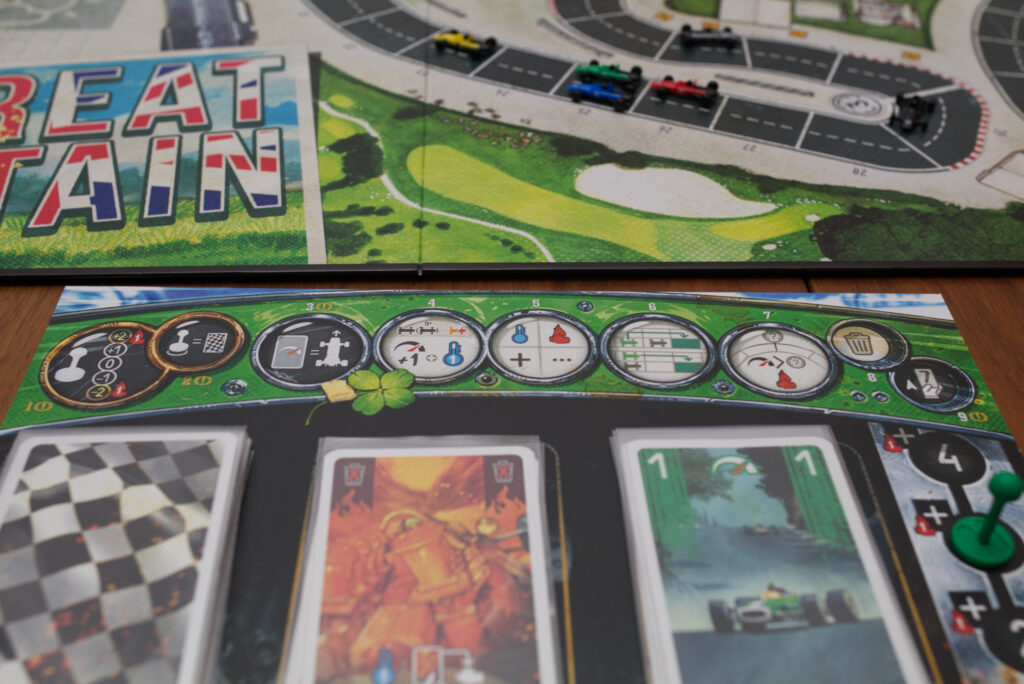
No, the actual boosting. Most people I play with don’t use it if they are in the lead. They don’t even remember it and only use it if they get desperate.
So, the boosting is also there as a means to alleviate the stress, if you use it correctly. Because the stress cards mean you are moving an unknown quantity forward where you might be happy with a certain interval and very unhappy with another interval, which is basically my core problem with Formula Dé right there, right? [chuckles].
We wanted to give players not a feeling of “oh, I just got the bad flip and now I’m out of the game” but give them some tools to help work around it. So the boost is there as a tool to try and see where the other players want to boost to get the slipstream, like adding more interaction points, which is also an issue in racing games. And I don’t see it as a catch-up mechanic. I believe even in modern racing today they are allowed some boosts at certain Formula 1 times, etc. So I don’t quite – but again [smiles] maybe it’s my lack of knowledge on the subject that’s speaking here – I don’t quite understand why boosting shouldn’t be thematic.
However, adrenalin, I certainly understand that. And that’s added as a gameplay feature because we want a family game, the same reason [as] with the spin outs which you asked about previously. Spin outs are certainly not thematic because most spin outs – or crashes: if you go very fast around a corner and you crash in Formula 1 – and certainly if you did so in the sixties – then you are out of the race, you are not getting back. So both of those things, the spin out rules and the adrenaline rules have been added to try to make sure that people are in it and it’s exciting [until] the end and everyone has a chance.
And then you can go on BGG and read the comments. [Alex laughs] I’ve read them, and you will find people in the comment section of the ratings saying that it’s impossible to pull ahead and the catch-up is so strong that it doesn’t matter what you do until the end. And then you will find other people saying that it’s impossible to catch a runaway leader once they have run away, and yeah, sure. We probably did a decent job then. [both laugh]
I was also thinking about this illusion of racing. When I think [back to] when I was a small child watching racing on the TV, there are two things absent [in Heat]: pit stops and crashes. I guess pit stops are difficult to do if you are only doing two or three laps of racing. And for crashing, as I understand you, it’s mainly “we want you to have a good time”.
Yes. Player elimination is something we generally got rid off in board games decades and decades ago. So I would be very happy in the future – if everything goes well – to make a legacy version where people can crash out and be removed from the game completely but we will see if the publisher people will enjoy that idea [laughs].
Designing Tracks
So these are the mechanics, the essence of the game, all the little bits you had to put in there. But then there is this whole huge topic of designing the tracks. In the game, there are four tracks and I was wondering why these four? Did you have certain goals – like lessons you wanted to teach players – or was it simply that you did tons of maps and these were the ones people liked the most?
We did tons of maps and we also focused on which ones people wanted. But there are also some very specific design goals. We wanted a track – which is the one you start playing – that is easy to play, that gets you moving fast and then have a decent high speed corner that you then learn how a corner works. Then you have a straight – this is the USA track – and then you get down to a sharp corner so you get the feeling of “oh, now I wanna go fast, oh oh, I shouldn’t have gone that fast” [Alex laughs]
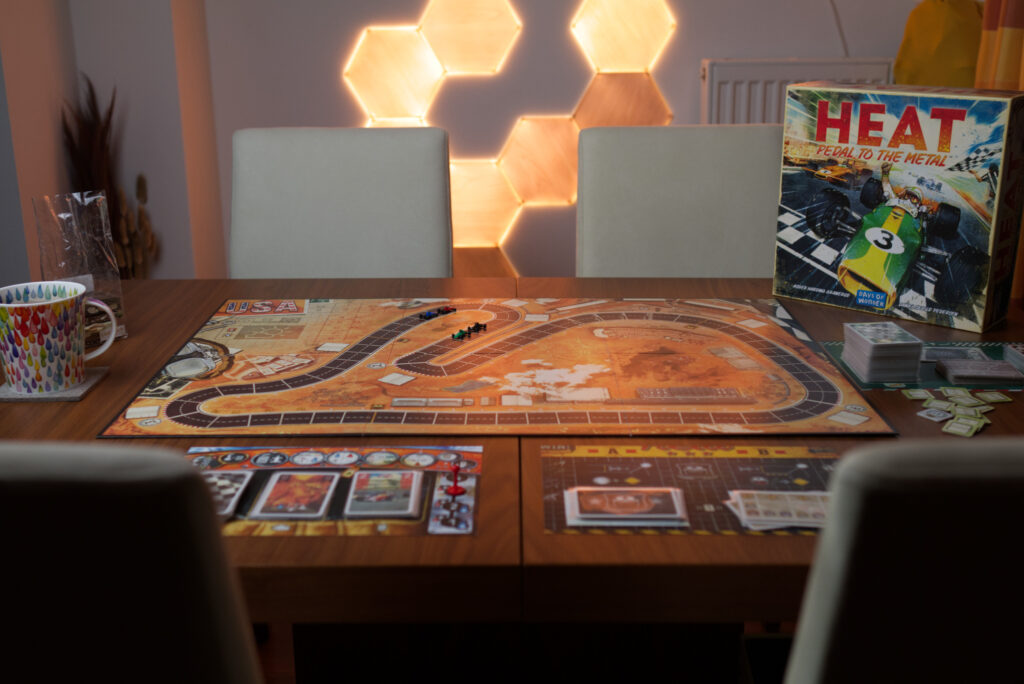
So we wanted something where we focused on you learning the game. We wanted something where we REALLY had a long straight, where you really had the potential to [gain] speed and not only that but need two turns of great speed, which is actually quite challenging to achieve. Again, [as] I mentioned before with the stress cards: if you play them at the right moment, you could have them out of your deck, right? But you could also make sure that once you come out on the Italy track where you want to move really, really fast that immediately after playing your three fours and your five – if you are playing the base game – that you are shuffling immediately after it so you had the potential on the very next hand to draw those same cards into your hand. This of course goes back to what you did two or three turns ago because why are you shuffling now?
So there is a lot of deck management potentially and then telling that story. It’s something that people might not experience or know about but it’s something you need a long straight to be able to experience because then you want the high cards on your next turns. Apart from that we just wanted some interesting tracks and we wanted some tracks with corners quite close to each other so you had the potential to do two corners in a round – which you can’t do on either the USA or Italy tracks – so you could experience that and trying that out. So there were some different smaller design goals for the different tracks.
Knowing Flamme Rouge, it was really a surprise that I opened the box and found like concrete maps instead of the brilliant puzzle piece system of Flamme Rouge. Why? Is it simply that it’s difficult to create a loop with puzzle pieces or did you want more control? What was the reason for the maps?
I think control is a big part of it because the placement of the corners and the distance between them can make a huge impact on exactly what kind of experience you are having and we wanted to try to take control of that. On top of it, there is just setup time. You can get to it much faster. And finally, there is also the full aesthetic presentation of a big Days of Wonder-, Vincent Dutrait-style illustrated map that just looks stunning on a table as a product as well. So it’s a mix of a lot of things that goes into such a decision.
It was a complete surprise [to me] how much I loved them. I opened the box and thought “oh, no modular track system” and then went “oh, this is so much easier”. All the numbers that are helping me and the lovely art.
You have the customisable tracks in Flamme Rouge. Here we tried to then – it’s probably one of your next questions – but we tried to give you the road conditions and the weather conditions as a means to then make those tracks playable again and again and again. And of course the hundred upgrade cards and millions of ways how you can construct your car.
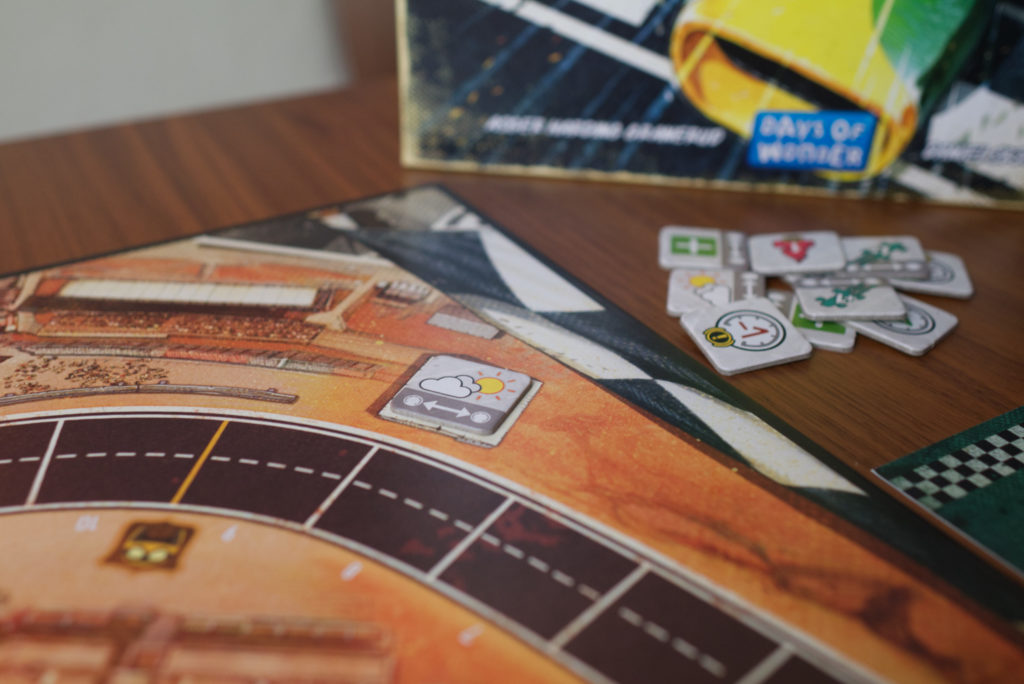
Yeah, you hit the nail on the head. The weather system, I’m just blown away with. It’s so much fun to think emotionally “oh my god, we are racing in the rain” or “god, we are racing in fog”. The immediate effects and the replay values it produces, it’s like: I don’t need modular systems anymore, I want this!
It’s a different modularity, right?
While designing Heat, did you figure out how to make “a good map”. Are there hidden design rules you found like “oh, every track should have this or that”?
Not really. Of course there are some things that probably don’t work. But what I learned from watching the Flamme Rouge community and them make their own tracks is that whatever design rules I make up are not necessarily good design rules for making tracks. Because people make all manor of tracks that I would have thought wouldn’t be great or wouldn’t be fun to play and then I tried some of them and it’s just a different challenge and maybe not something I would have ever included in the base game because of some breaking of illusions, etc. But it still works. We’ll see. We are working on a lot of new tracks for upcoming expansions and some of the things we thought were set in stone are already changing as well.
This concludes part 1. In part 2, Asger and I talk about the design of the Legends system, their partnership with Days of Wonder, the challenges of fulfilling huge demand, and how he and Daniel approach working on future content for Heat: Pedal to the Metal.
If you enjoyed reading this, please leave a feedback in the comments. Doing in-depth interviews like these takes a lot of prep & research and it’s really rewarding to see that so many of you seem to enjoy reading them. Showing your support helps getting future interview partners on board! You can find more interviews like these in the interview section.
(Disclaimer: Since Asger and I are both non-native English speakers, I made some smaller corrections to ease the flow of reading and marked them accordingly. Also I have to stress what a fun conversationalist Asger is as this will be difficult to convey in the transcript alone. Whenever he made comparisons to other games or recounted internet comments he had seen, it was with appreciation and respect in his voice, a huge twinkle in his eyes and a smile on his lips.)
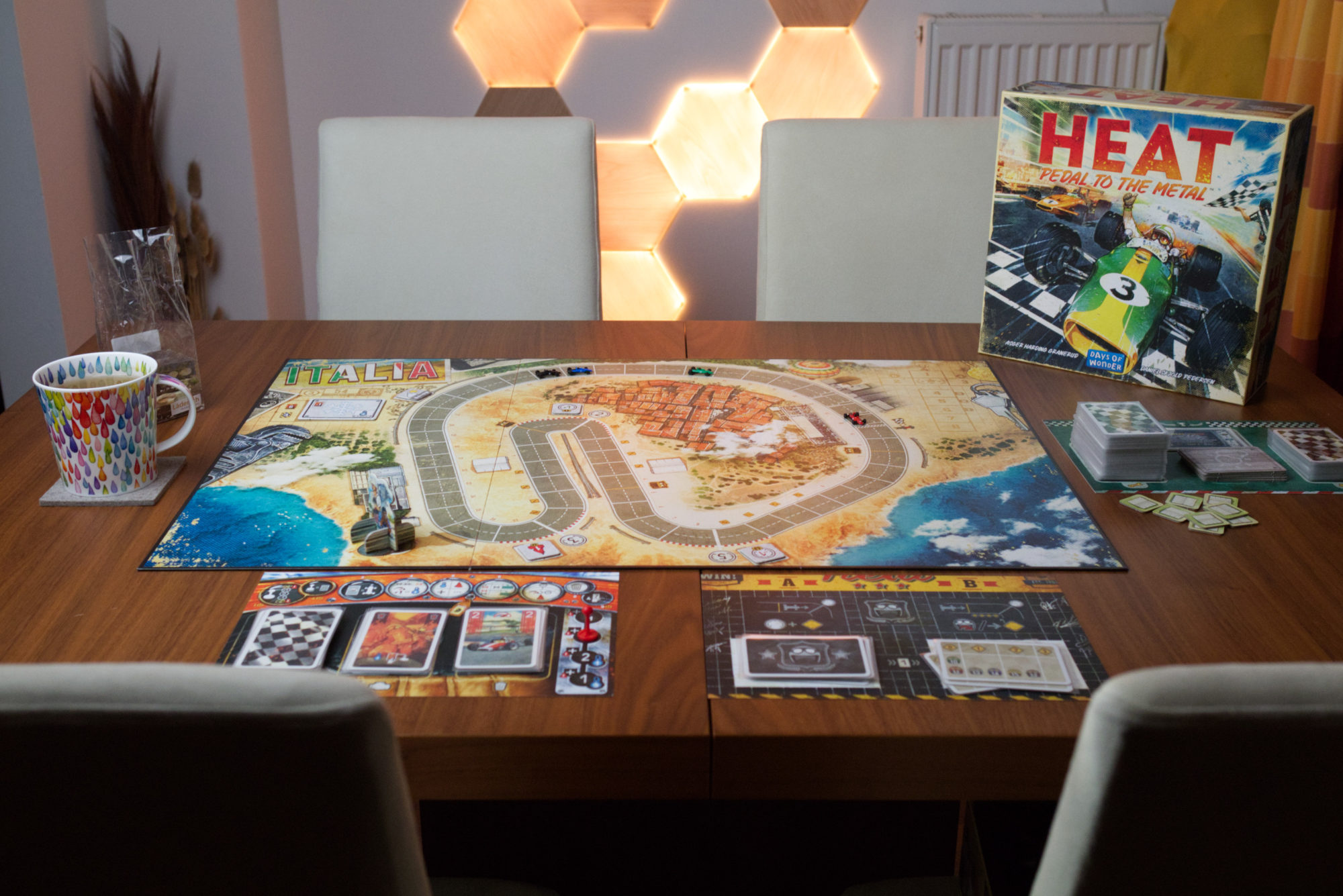
What a pleasure to read. The questions were pertinent and the responses were so easy to read and enjoy.
I certainly learnt a strategy I hadn’t considered, which might be obvious to other players. Sweet. Great job and great game. 🙂👍🙏
Thanks for the compliment, Steve! Yeah, I also got 2-3 new ideas how to play Heat out of it 🙂
Alex,
Thanks for putting so much effort into your interview! As a native English speaker, it was easy to follow the questions and answers; it doesn’t need to be perfect. Great work! Looking forward to part 2!
Hi Alex, first off: I greatly appreciate what you are doing here! It’s wonderful and enlightening to find out more about the thought-processes of designers.
I do want to leave some feedback on the format here: as a former editor I like to share it is perfectly fine to edit sentences and leave out the filler words, double words and fill out sentences without using brackets. All interviews in magazines are heavily edited for readability. I don’t mean to discredit your effort, but my enjoyment would go up a lot if these details would be smoothened out.
Thanks Ivo for the interesting feedback, I really appreciate it.